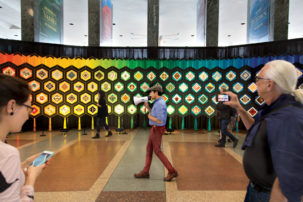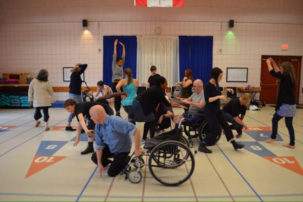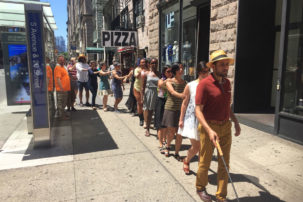There is a big push in the media and in the art world these days for “diverse” perspectives. This push mirrors “diversity” being used as a buzzword in boardrooms, governments and education as well.
But what does “diversity” really mean if the actual voices of so-called diverse individuals aren’t truthfully represented in mainstream media and in popular art discourses? How can journalists, critics, curators and gallery workers confront—rather than reinforce— tokenism and marginalization of minority voices?
This is something I’ve been thinking about quite a bit lately. Attending a recent symposium in Toronto called Cripping the Arts, I found I wasn’t alone in these thoughts and concerns. There, for the first time, I found that many of my feelings stem from a long tradition of misrepresentations of people with illness and disability in the media, curation and in art-world texts. I learned that others had also been misrepresented. And I learned a wider movement is afoot.
My hope is that this essay will open a door toward positive change. My view is that artists, critics, journalists, curators and gallery workers all have a responsibility to work together to ensure that truly “diverse” perspectives are heard and understood. And while I focus this essay on “disability,” and my experiences with that term, I also want to recognize that artists impacted by other forms of labelling—be they around ethnicity, class, gender, or otherwise—need to be respected and heard more widely too.
When my disability is not foregrounded in gallery texts, journalists ask very different kinds of questions than if it is mentioned there.
One thing I’ve noticed that when my disability is not foregrounded in gallery press releases and exhibition statements, reporters ask very different kinds of questions than they do when my personal life circumstances are mentioned up front.
For instance, when CBC’s The Exhibitionists did an interview with me about A Warm Hug—an interactive sculpture recently on view at Ontario Place—they asked things like, “What’s the purpose of your work? What effect do you hope it will have?” The resulting storyline was, roughly, “Here’s an artist named Kanika, and here’s her intention for her art.”
In contrast, when I did media interviews for “Rethink Recovery”—a show at Lakeshore Arts in 2017 and Toronto Rehab Hospital in 2018—I heard a lot more questions like: “How does your art help you cope with your illness? How, with all your challenges, do you manage to create?” And the resulting storyline was more like “Here’s what happened to Kanika. And here’s what she did after that happened to her.” It’s more of a human-interest story than an art story.
In placing the “cause” first and the art second, such narratives oversell the disability and undersell the art. In them, my message and intention get distorted—and such storylines prompt readers to think that how I live with my disability is more important than the art.
Rather than thinking of my artworks as dramatizing the change that I personally experienced, I’d rather that journalists and curators might use my work to talk about the theme of relating to change in general—something everybody experiences to one degree or another.
In fact, my “Rethink Recovery” show was, for me, entirely about change—art that works through change, and how we can all relate to and come to accept change.
One draft press release for a gallery used the word “catastrophic” to describe what happened to me—a word that I don’t identify with.
Some stories I heard at Cripping the Arts reminded me of the power that labels hold. Artist Aaron Labbé, speaking on a panel, noted that for a long time, people would talk about his tech-based art in terms of contemporary critical discourse. But when he added the term “mad-identified” to his bio, people started to talk about his art much more in terms of “therapy.”
The framing of these storylines starts before journalists get to them, of course. They start in the art gallery or exhibiting institution, and its own texts and materials. So more nuance is needed here, too.
In some cases, I’ve had intense negotiations with some galleries, trying to keep mention of my disability out of press releases and exhibition wall texts. This is a conscious choice that I’m making, as I feel referencing my personal details aren’t relevant to these artworks.
In other cases where I do agree to include information about my disability and personal experience in gallery materials, I need to ensure the terminology is correct. In one instance, I found out a gallery was going to issue a press release and postcard text that used terminology I never would have used in real life. That press release and postcard used the word “catastrophic” to describe what happened to me—a word that I don’t identify with. I was not explicitly consulted on this point; I only caught the error when copied on an email chain for other reasons. I’m relieved we were able to flag and change it—but many artists like me are never even given that chance, and that remains a problem.
Another story I heard at Cripping the Arts reminded me I am not alone in this concern. On a panel, critic Shay Erlich said there is some pretty innovative stuff coming out of the disability arts space, but many viewers—and critics—are not able to detach the disability from the art. I related to that.
From my point of view, when art gets labelled as “art therapy,” or is framed in such a way that cannot be decoupled from disability (even when that’s what the artist desires), then what we are left with is a huge missed opportunity. Then, we no longer have the chance to add to contemporary art discourse, and to reach wider audiences. And viewers may lose the chance to learn about complex insights in our work that are relevant to their own lives.
I do think positive change is possible. I want to make the galleries I’m exhibiting in more accessible than they were before.
Sometimes when I have tried to express these kinds of disappointments and misrepresentations in the past, I’ve heard feedback like: “That’s just what the media does,” or “That’s just how it goes with galleries.” Usually this is followed up with something to the effect of: “Be happy you got the coverage/opportunity and move on.” And I do know emerging artists have to seek out as many opportunities as possible to get their work out there.
But just because many people experience media and art institutions this way, does that mean we have to accept it? Does that mean we can’t change? Does that mean we can’t expect more? Or can’t do things better?
I, for one, do think positive change is possible.
To start with, I as an artist want to take more responsibility for doing my part in making information flows with media and gallery workers more respectful and accurate.
For instance, I’ve heard of some artists who specifically address desired language around identity and artwork in their press packages, and this is something I’m considering doing in future as well.
One of the ways I’ve also been trying to make change is to make the galleries I’m exhibiting in more accessible than they were before. As someone who is challenged in navigating public spaces due to auditory and sensory stimuli, I’m committed to making my artwork and experience of viewing it as accessible as possible. This includes considering issues of light, energy and the ability to participate and experience art in different ways when installing a show.
For instance, for my recent show “Surrender” at the Clay and Glass Gallery, I asked for larger font sizes in wall texts. When the gallery expressed concerns about aesthetics and consistency with existing guidelines, together we came up with another solution—laminated large-print handouts viewers could take with them through the galleries. I’m hoping they will use those in other exhibitions moving forward, too. I’m hoping it’s a standard that they will adopt in the years ahead.
If thousands of dollars and hundreds of hours go into hosting an exhibition, why not budget just a few more days—or just a bit more time—to ensure the works and the artist are being properly represented?
And I do have an ask for art galleries and journalistic media too. I’ll preface it by saying that I do understand that the under-resourced nature of both art galleries and journalistic media right now puts a lot of time pressure on journalists and arts workers. This condition can lead to tight deadlines and reactive behaviour—both of which are not conducive to making space for more conversations with artists about what terminology to use and which narratives are most respectful.
My ask here is that timelines be re-evaluated, at least on the gallery side, to ensure proper terminology around an exhibition. I say: if thousands of dollars and hundreds of hours go into hosting an exhibition, and many months, even years, have gone into creating the exhibited works themselves, then why not budget just a few more days—or just a bit more time—to ensure the works and the artist are being properly represented? So many exhibitions are programmed months in advance; I would hope that gallery workflows might be managed to leave room for more feedback and conversation.
I also want to ask whether some of the things largely regarded as “impossible” in mainstream journalism and art criticism could be made more flexible. I know it’s a faux pas in the media world to have the subject of an article review the draft text written by a journalist before publication—but perhaps there’s a middle ground that can be found. For example, could artists be given the opportunity to flag misrepresentation specifically?
All this takes more effort—rather a different effort—than perhaps most journalists, gallery workers and even artists are accustomed to. But the fact is that once an article is published, it’s too late to make needed corrections. I say, let’s seize opportunities for dialogue and education as early in the exhibition and media process as possible.
There are so many ways to think about access, both for audiences and for artists. Some of what I’ve said here might feel complex or overwhelming to some readers. Or it may seem obvious to others.
As I think through all this, I also want to recognize the intensive work that many artists within and beyond the disability scene have been doing to push back against tokenism and misrepresentation. These are struggles that have been ongoing for many, many years, even if I am new to them.
Ultimately, a change toward a more authentic “diversity” is something I really do believe is possible. It might be slow, it might sometimes be half-steps. But we can move the needle. It begins, I think, with a sincere desire to change—and letting artists have room to help others understand their choices.

 Kanika Gupta, Imperfect, 2018. Black and white photograph.
Kanika Gupta, Imperfect, 2018. Black and white photograph.







